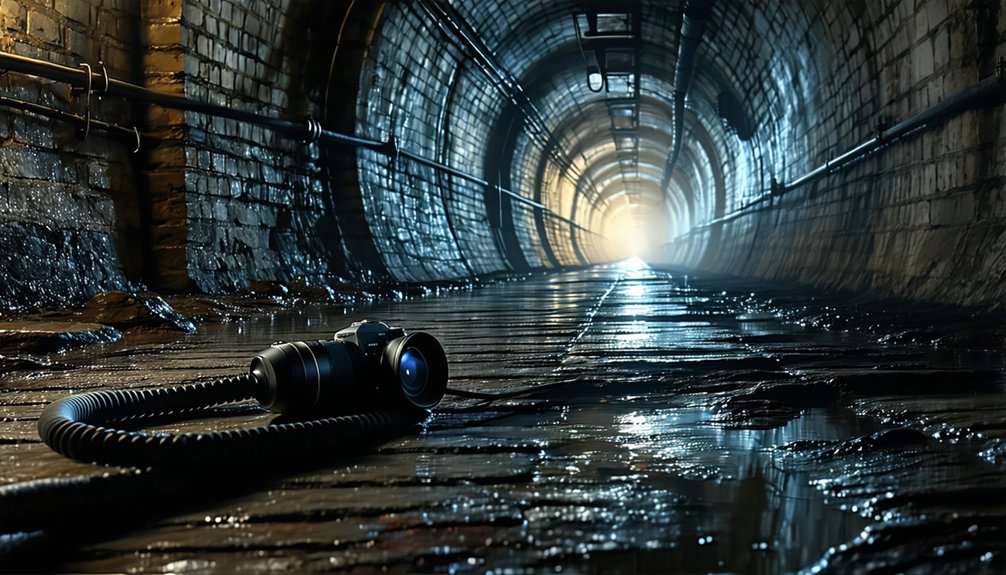Top advanced techniques for sewer line diagnostics include CCTV inspection technology, advanced data analysis, and robotic crawlers. CCTV employs high-definition cameras mounted on robotic crawlers for real-time assessments of sewer conditions, detecting critical issues like leaks and blockages. Advanced data analysis enhances diagnostic accuracy by identifying anomalies and recognizing deterioration patterns. Robotic crawlers reduce inspection time and labor costs while maintaining environmental integrity. These methods collectively improve maintenance strategies, ensuring better performance and longevity of sewer systems. Further insights await exploration.
How CCTV Inspection Technology Enhances Sewer Diagnostics
As municipalities increasingly prioritize efficient sewer management, CCTV inspection technology emerges as a pivotal tool for enhancing sewer diagnostics. This advanced inspection method employs robotic crawlers equipped with high-definition cameras, allowing for real-time visual assessments of sewer line conditions without invasive digging. By effectively detecting blockages, leaks, cracks, and corrosion, CCTV inspections provide thorough insights into sewer line health.
The technology enables early problem detection, which can avert costly repairs and mitigate the risk of severe sewer line failures. Post-inspection reports, generated with clarity, pinpoint specific concerns while offering actionable maintenance recommendations that contribute to improved sewer system management. Furthermore, CCTV inspections support proactive maintenance strategies by establishing a permanent record of sewer line conditions, facilitating ongoing monitoring and timely interventions. Consequently, this innovative diagnostic tool is essential for municipalities aiming to maintain peak sewer line functionality and guarantee long-term sustainability.
Benefits of Advanced Data Analysis in Sewer Inspections
The integration of advanced data analysis into sewer inspections greatly enhances diagnostic accuracy and operational efficiency. By employing real-time video footage in conjunction with sophisticated software algorithms, inspection teams can accurately identify anomalies such as leaks and blockages. This data-driven methodology allows for the recognition of patterns in pipe deterioration and root intrusion, promoting proactive maintenance and markedly reducing the risk of expensive emergency repairs.
Moreover, advanced data analysis facilitates the generation of thorough reports that pinpoint critical intervention areas, thereby aiding informed decision-making in sewer system management. Utilizing predictive analytics, this approach can forecast potential issues based on historical performance data, enabling municipalities and property owners to allocate budgets for repairs effectively. Ultimately, the application of data analytics leads to optimized maintenance schedules and improved resource allocation, enhancing overall system performance and extending the lifespan of sewer infrastructure.
The Role of Robotic Crawlers in Pipe Inspection
Utilizing robotic crawlers in pipe inspection revolutionizes the traditional methods of evaluating sewer infrastructure by offering a non-invasive solution to identify critical issues. These advanced devices are equipped with high-definition cameras that capture real-time video footage, facilitating thorough visual inspections. They navigate complex pipe systems, efficiently detecting blockages, leaks, cracks, and corrosion.
| Key Features | Benefits |
|---|---|
| Real-time video | Immediate issue identification |
| Structural integrity assessment | Enhanced maintenance planning |
| Material identification | Improved resource allocation |
Robotic crawlers incorporate additional sensors to measure pipe diameter and assess structural integrity, greatly reducing inspection time and labor costs. This technology minimizes disruption to the surrounding environment, supporting proactive maintenance strategies. Consequently, detailed reports generated from inspections foster early detection of potential problems, ultimately enhancing sewer system performance.
Frequently Asked Questions
What Are the Methods of Testing a Sewer Line?
Various methods exist for testing a sewer line, each serving distinct purposes. Video inspection utilizes high-definition cameras to assess pipe conditions, while leak detection employs sonar technology and acoustic sensors to pinpoint issues. Smoke testing reveals leak locations by observing escaping smoke, and dye testing confirms the integrity of connections. Pressure testing evaluates the system's strength, and trenchless methods can address root intrusion without extensive excavation, ensuring efficient and effective diagnostics.
What Are the Methods of Sewer System Inspection?
Like a lighthouse guiding ships through fog, effective sewer system inspection illuminates hidden issues. Methods such as CCTV Inspection provide detailed pipe visuals, while Smoke Testing and Dye Testing reveal leaks. Hydrostatic and Pressure Testing assess structural integrity, complemented by Acoustic Leak Detection for pinpoint accuracy. Visual Inspection offers immediate insights, and Trenchless Technology facilitates repairs without disruption. Additionally, Infrared Thermography and Fiber Optic Inspection enhance diagnostics, ensuring systems remain efficient and resilient.
Which One of the Following Tests Is Used for Testing Sewer Pipes?
The question of which tests are utilized for sewer pipe evaluation encompasses several advanced methods. Video inspection employs high-definition cameras for real-time visual evaluations, while pressure testing is essential for leak detection, appraising the integrity under pressure. Smoke testing identifies leaks through non-toxic smoke, and dye testing can reveal unauthorized connections. Additionally, acoustic monitoring and flow measurement provide analytical insights, complementing trenchless technology and structural analysis for thorough sewer system diagnostics.
What Are the Techniques of Sewer Rehabilitation?
Sewer rehabilitation techniques encompass various methods aimed at restoring functionality while minimizing disruption. Key techniques include cured-in-place lining, which creates a new pipe within the old one, and pipe bursting, which replaces damaged pipes by breaking them apart. Slip lining and structural lining enhance existing pipes' durability, while chemical grouting seals leaks. Trenchless technology reduces excavation needs, and manhole rehabilitation addresses structural integrity, ensuring effective sewer relining and pipe replacement when necessary.



